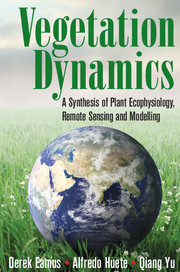Book contents
- Frontmatter
- Contents
- Preface
- Section One Plant Ecophysiology
- Section Two Remote Sensing
- Section Three Modelling
- 8 An Introduction to Modelling in Plant Ecophysiology
- 9 Modelling Radiation Exchange and Energy Balances of Leaves and Canopies
- 10 Modelling Leaf and Canopy Photosynthesis
- 11 Modelling Stomatal and Canopy Conductance
- 12 Modelling Leaf and Canopy Transpiration and the Soil-Plant-Atmosphere Continuum
- 13 Coupling Models of Photosynthesis, Transpiration and Stomatal Conductance and Environmental Controls of Leaf Function
- Section Four Case Studies
- Index
- References
10 - Modelling Leaf and Canopy Photosynthesis
from Section Three - Modelling
Published online by Cambridge University Press: 05 June 2016
- Frontmatter
- Contents
- Preface
- Section One Plant Ecophysiology
- Section Two Remote Sensing
- Section Three Modelling
- 8 An Introduction to Modelling in Plant Ecophysiology
- 9 Modelling Radiation Exchange and Energy Balances of Leaves and Canopies
- 10 Modelling Leaf and Canopy Photosynthesis
- 11 Modelling Stomatal and Canopy Conductance
- 12 Modelling Leaf and Canopy Transpiration and the Soil-Plant-Atmosphere Continuum
- 13 Coupling Models of Photosynthesis, Transpiration and Stomatal Conductance and Environmental Controls of Leaf Function
- Section Four Case Studies
- Index
- References
Summary
Introduction
Physiological responses to a changing environment have been intensely studied in the past decade at all spatial levels, from sub-cellular and leaf-scales through to regional and global scales. Simulation models of physiological processes in response to environmental factors are the basis of the study of the interactions between plant and environment, such as the effects of global warming and elevated atmospheric CO2 concentrations on vegetation. Such models also investigate the role that plant cover plays in determining patterns and rates of climate change (i.e. the feedbacks between plant cover and climate). Leaf-scale studies are the starting point of any examination of interactions between vegetation and atmosphere but the understanding of the feedbacks between leaf and atmosphere constitute the building blocks in modelling processes at larger scales through up-scaling (Norman 1993, Jarvis 1995).
The biophysical and physiological processes at leaf-scales may be summarised as radiation exchange, heat and water transfer, physiological regulation and biochemical reactions (Fig. 10.1). Plants can alters these processes in response to changes in environmental drivers, including solar radiation, temperature, humidity and soil water and nutrient contents, as well as CO2 concentration. Thus:
(1) Energy exchange: solar radiation is the key input of leaf energy balances which drive transpiration, in addition to it being the energy source for photosynthesis. The net radiation balance of a leaf is partitioned into sensible heat by heat conductance and turbulent transfer and latent heat by transpiration. Leaf temperature, as determined by leaf energy balance, influences the biochemical reaction rates of all photosynthetic processes and thereby the photosynthetic rate. Leaf temperature determines the leaf's emission of long-wave radiation and also determines the saturated water vapour pressure in the sub-stomatal cavity (Chapter 2). Consequently leaf temperature influences stomatal conductance and transpiration.
(2) Mass flow: CO2 and water vapour pass into and out of stomatal pores respectively. The CO2 flux and water vapour transfer are determined by stomatal conductance, boundary layer conductance and differences of CO2 and vapour pressure between the sub-stomatal cavity and ambient air. In these processes, there are complex interactions between photosynthesis, stomatal conductance and intercellular CO2 concentration.
(3) Physiological regulation and biochemical reactions: Stomatal regulation is based on complex physiological processes that are regulated by light and water availability, CO2 concentration, as well as the hormone ABA. Photosynthesis is influenced by solar radiation, leaf temperature and intercellular CO2 concentration (Ci).
- Type
- Chapter
- Information
- Vegetation DynamicsA Synthesis of Plant Ecophysiology, Remote Sensing and Modelling, pp. 260 - 280Publisher: Cambridge University PressPrint publication year: 2016



